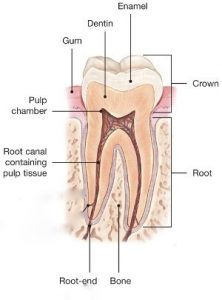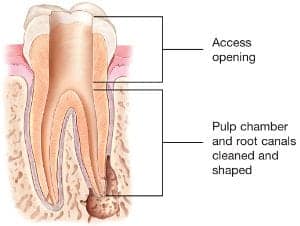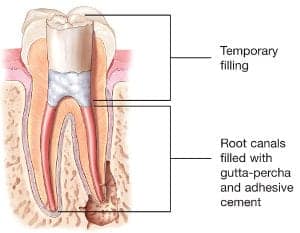Assignment 1:3: Technical Definitions
Date: June 10, 2022
Author: Kristy Vyfschaft, ENGL 301 Student
Introduction
The use of definitions is an important part of communication. The objective of this assignment is to define a technical term to a non-technical audience. The term is defined using parenthetical, sentence, and expanded definitions. The purpose of these definitions is for a dental professional to explain a technical dental term to patient with no dental knowledge who needs the treatment that is defined.
Parenthetical Definition:
Endodontic therapy (root canal treatment) is a procedure performed to save an infected tooth.
Sentence Definition:
Endodontic therapy is a dental procedure to treat a tooth that is internally inflamed or infected.
Expanded Definition:
What is Endodontic Therapy?
Endodontic therapy (root canal treatment) is a dental procedure performed by a dentist as an opportunity to save a tooth rather than remove a tooth. The term endodontic originates from the Greek word endo for “inside” and odont for “tooth” therefore endodontic therapy is treatment for the inside of a tooth (American Association of Endodontists [AAE], 2022).
When is Endodontic Therapy Needed?
This treatment is required when the centre of the tooth becomes inflamed or abscessed (infected at the root) from deep cavities, poor dental work, a crack in the tooth, or an injury.
Is the Treatment Painful?
The procedure is commonly believed to cause pain, but the pain felt is from the infection (AAE, 2022; Brazier, Y., 2017; CDA, 2022). Endodontic therapy will relieve pain or toothaches and will not cause any more pain than having a cavity filled. Mild sensitivity after the procedure is not uncommon but can be relieved with over-the-counter pain medications (AAE, 2022; Brazier, Y., 2017).
How is Treatment Completed?
Inside the tooth, under the hard layers of enamel and dentin, there is a soft tissue called the pulp. The pulp contains blood vessels and nerves that create the hard tissues during the development of the tooth and provide temperature and pain sensations (AAE, 2022; Brazier, Y., 2017). The pulp extends from the crown, above the gums, to the root tips, below the gums. (see Figure 1 and 2)

FIGURE 1. A Healthy Tooth
Source: From American Association of Endodontists, n.d., https://f3f142zs0k2w1kg84k5p9i1o-wpengine.netdna-ssl.com/patients/wp-content/uploads/sites/3/2017/08/Root-Canals-Explained.jpg

FIGURE 2. An Infected Tooth
Source: From American Association on Endodontists, n.d., https://f3f142zs0k2w1kg84k5p9i1o-wpengine.netdna-ssl.com/patients/wp-content/uploads/sites/3/2017/11/abscessed-tooth.jpg
The procedure is like having a cavity filled except that a routine filling only treats the hard layers of enamel and dentin by removing the cavity and does not extend into the inner parts of the tooth. A tooth with an infected pulp is treated with endodontic therapy by removing the pulp from the tooth (AAE, 2022; CDA, 2022). First, the area will be numbed with local anesthetic (freezing) and a rubber protective sheet is placed to isolate the tooth. An opening is created in the top of the tooth and small dental instruments are used to clean the pulp and root canals. The canals are disinfected and flushed out. (see Figure 3) After the space is cleaned the root canals and pulp are filled with gutta percha (a rubber-like material) to ensure complete sealing of the root canals. Lastly, a permanent or temporary filling is placed to seal the opening on the top of the tooth (AAE, 2022; Brazier, Y., 2017; CDA, 2022; “Root canal”, 2022). (see Figure 4)

FIGURE 3. A Tooth Cleaned Out, Before Filling.
Source: From American Association of Endodontists, n.d., https://f3f142zs0k2w1kg84k5p9i1o-wpengine.netdna-ssl.com/patients/wp-content/uploads/sites/3/2017/08/Root-Canal-Access-Opening-300×226.jpg

FIGURE 4. A Treated and Filled Tooth
Source: From American Association of Endodontists, n.d., https://f3f142zs0k2w1kg84k5p9i1o-wpengine.netdna-ssl.com/patients/wp-content/uploads/sites/3/2017/08/Root-Canal-Filling-300×233.jpg
What Happens if the Tooth is Not Treated?
If the tooth with pulp inflammation is left untreated a dental abscess can develop. Without endodontic treatment an infected tooth will become loose and need to be taken out (Brazier, Y, 2017). The dental infection can spread to other teeth and through the body, potentially becoming life-threatening (AAE, 2022; “Root”, n.d.).
Endodontic therapy treats an infected tooth, alleviates pain, and prevents tooth loss. Please contact a dental professional for any questions or concerns about endodontic therapy.
References
American Association of Endodontists. (2022). Root canal explained. Retrieved June 5 2022, from https://www.aae.org/patients/root-canal-treatment/what-is-a-root-canal/root-canal-explained/
Brazier, Y. (July 26 2017). Root canal treatment: Everything you need to know. Retrieved June 5 2022, from https://www.medicalnewstoday.com/articles/142780
Canadian Dental Association. (2022). Joint public statement on root canal treatment from the Canadian dental association and Canadian academy of endodontics. Retrieved June 5 2022, from http://www.cda-adc.ca/en/oral_health/talk/procedures/root_canal/default.asp
Root canal treatment. (n.d.) TheFreeDictionary.com. Retrieved 5 June 2022, from https://medical-dictionary.thefreedictionary.com/root+canal+treatment
Root canal treatment. (2022). Retrieved 5 June 2022, from https://www.nhs.uk/conditions/root-canal-treatment/